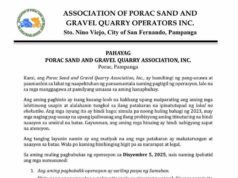Athletic stadium in all its splendor. Photo courtesy of Borj Meneses
CAPAS, Tarlac — The euphoria over hosting the 30th Southeast Asian Games is set to dissipate after its dramatic conclusion at the Athletic Stadium at New Clark City here last Dec. 11.
Now the question expected to resurface is: Will not the rising city’s Athletes’ Village head towards being a white elephant as did most other grand structures built for international sports events worldwide?
Sen. Sonny Angara, chair of the Senate committee on finance, said during a Senate hearing that P188 million has been allocated for the maintenance of the SEA Games facilities: P120 million for the athletic stadium, P50 million for the aquatic center, P10 million for the Athletes’ Village maintenance and P8 million for the warmup track. He did not say the length of time covered by the allocation.
He downplayed fears that the village would become a white elephant, citing rental and sponsorship opportunities for the multimillion-peso SEA Games facilities in the future. The Bases Conversion Development Authority (BCDA) which has jurisdiction over the NCC, has already made initiatives towards this, he noted.
Indeed, the BCDA has announced recently that NCC will host the 11th Asian Swimming Championships (ASC), quoting Philippine Swimming Inc. president Lailani Velasco as saying “the quadrennial meet organized by the Asian Swimming Federation (AASF) consists of five disciplines namely swimming, diving, water polo, artistic swimming and open water swimming.”
It will be held Nov. 7-17, 2020 at the 2,000-seater NCC Aquatics Center, BCDA said.
And there’s also the big potential of the Athletes’ Village being rented by athletes to train for the 2020 Olympics in Tokyo.
Plus, Sen. Sherwin Gatchalian, chairman of the Senate committee on basic education, arts and culture, has bared plans to build at the NCC a Philippine High School for Sports that will “unleash the potential of young Filipinos who have shown early potential of excelling in sports for a sports-related career.”
All these positive views facing the odds of sports history.
Study
In their joint study, Isao Okada of the Osaka Seikei University and Stephen A. Greyser of the Harvard Business School observed that “In recent years, the total spending on hosting the Olympic Games has snowballed. The 2008 Beijing Olympic Games spent $40 billion on infrastructure development, and the 2014 Sochi Winter Olympics reached $50 billion.”
“Even when the glorious but costly Olympic Games come to an end, significant maintenance and operating costs for publicly-owned large Olympic venues, which were constructed or renovated for the Games, continue to burden host cities and states for a long time afterward. Unless Olympic venues are used effectively after the Games, and can earn enough revenue to cover large on-going costs, their owners — local governments and taxpayers — must pay off the deficits. Summer Olympics stadiums, normally built to seat over 70,000 people, are particularly at risk of becoming white elephants,” the study said.
The study recalled that “for the Athens 2004 Olympic Games, in the vast 2,509-hectare (6,200 acres) land of the former international airport in south Athens, called the Hellinikon Area, the Greek government constructed the sports complex, which consisted of six sports grounds including baseball stadiums and a canoe/kayak slalom, and two training facilities. After the Games, Hellenic Olympic Properties (HOP), the government- controlled management authority for the post-Olympic use of each venue, was established and started to shape a plan for the utilization of the Olympic venues.”
It noted that “Now, 14 years on from the Olympic Games, the abandoned rusty sports complex in the Hellinikon Area has turned into refugee camps pitching white tents for mostly Syrians and Afghans who ran away from civil war.”
Bird’s Nest
The study also zeroed in on the then famous The Bird’s Nest, with its iconic design of latticed steel frames, for the 2008 Beijing Olympic Games, and is now “also struggling to host events filling the full capacity of 80,000 seats.”
“Despite the fact that the Bird’s Nest had become a national symbol, the group controlling its post-Olympics development rights had to abandon its efforts to sell naming rights to the venue as well as to create a shopping and entertainment complex anchored by the Bird’s Nest,” the Associated Press reported the following year in 2009.
The study said that “as a result, a consortium consortium led by a China International Trust and Investment Corp. Group, the state-owned company, transferred the 30- year concession back to the Beijing municipal government only one year after the closure of the Olympic Games.”
“Reminding Chinese people of the uplifting feeling at the 2008 Beijing Olympic Games, the Bird’s Nest still attracts hundreds of thousands of domestic tourists. However, it is true that the Bird’s Nest suffers under an estimated annual $11 million operating costs,” the study said, quoting a source.
It also noted that “relying heavily on ticket revenues from stadium tours, the operator of the Bird’s Nest works very hard to attract tourists…”
“Because of the growing criticism among taxpayers worried about the enormous expenditures, many cities, such as Oslo, Stockholm, Lviv (Ukraine) and Krakow (Poland), had dropped out of the race for the 2022 Winter Olympics, and Boston, Budapest, Hamburg and Rome also withdrew their efforts to stage the 2024 Summer Olympic Games,” the study pointed out.
The study, however, pointed out factors that could prevent such huge sports infrastructure from evolving into white elephants, citing such factors as effective re-use, sustainability, and legacy. It said sustainability covers refurbishment and continuous reinvestment after the games and mass transit.
Questions
At NCC’s Athletes’ Village, would continuous reinvestment be feasible amid maintenance cost? Would mass transit be provided for better access to the village in rural Capas, Tarlac?
Still, the BCDA is confi dent of getting its return of investment (ROI) on the Athletes’ Village.
In an interview with bluprint.onemege.com last July, BCDA president-CEO Vince Dizon said: “As in any privatization effort, part of the revenues that are generated from the operations of the facilities goes to the government. The government gets a revenue share from the private sector, and that’s how the government recovers the funding in several years. But you know, it is the government’s responsibility to build structures like these. The private sector will never build something like this for the public because they are not going to be able to recover it in the span of time they want. Typically, the private sector wants to recover in 5-7 years.”
So, who in the private sector would be so kind as to wait beyond seven years before profiting from the Athletes Village?
It is perhaps a question better taken from the view of climate change. The NCC, which hosts the sports village, is being sold on the premise that it can withstand the ravages of nature better than Metro Manila.
More than 167,000 hectares of coastland are projected to go underwater in the Philippines, especially in low-lying island communities, according to research by the University of the Philippines.
The World Meteorological Organisation has warned that the water levels around the Philippines are rising at a rate almost three times the global average due partly to the influence of the trade winds pushing ocean currents.
The Department of Environment and National Resources has its own climate change office “educating” communities in high-risk areas, including teaching communities to adapt to rising sea levels by ensuring that public spaces, such as community halls and schools, are not built near the coast.
Scarier
A new study, published in October 2014 in Environmental Research Letters, paints an even scarier picture. Sea levels could rise by a maximum of 190 centimetres (higher than the average person) by the end of the century.
Metro Manila cities such as Manila, Navotas, Malabon, Pasay are likely to be affected by coastal flooding.
Climate Central, composed of independent scientists, said in a study release last October that roughly 30 years from now, major cities in the National Capital Region could likely be submerged as coastal flooding is seen to become extensive worldwide by 2050 due to climate change.
BCDA’s Dizon had this picture in mind even when the NCC, along with the Athletes’ Village, was under construction. He has cited Clark location’s “natural resiliency.”
He said on bluprint.onemega.com: “the main indicator of the area’s resiliency is when the Americans chose it to be the major US base. They didn’t just choose it randomly; they chose this because of its natural resiliency: its elevation, natural contour, and its distance from a fault line. Metro Manila has an average elevation of 1.5 to 2 meters above sea level. The entire 32,000-hectare Clark area is at 65 to 70 meters above sea level, and that is the lowest area in Clark. Also, this site was not meant to be fl at. Nature designed it to be undulating, so it adds to the resiliency. It protects us from floods and all sorts of possible natural problems in the future. Lastly, we are 20 kilometers away from the nearest fault line, the East Zambales fault to the northwest.”
Dizon’s picture
Dizon further said: “It’s good to start with the big picture. Under the Build Build Build (BBB) program of the government, Clark—not just the New Clark City, but the entire development of Clark—is one of the centerpieces of that unprecedented infrastructure build-up. The role of Clark in that huge BBB program, which aims to spend anywhere between 150 and 160 billion US dollars (about 8 trillion pesos) within the six-year term of President Duterte, is to create a new metropolis for the country. The role of the BCDA is to spearhead that development because this entire land area of Clark is all under its purview, and creating the new metropolis is the main focus of what we’re trying to do right now.”
“Let’s discuss the need for a new metropolis. If you live in Metro Manila, you’d probably know why there is a need for it. Right now, there is only one major metropolis in the country and that is Metro Manila. Metro Cebu might be big, but it also has the same problems as Manila. So, let’s put it this way: there’s only one major metropolis in Luzon, which has about 60 million people. Given that you only have one major metropolitan center servicing 60 million people, it shouldn’t come as a surprise why Metro Manila is the way it is,” he added.
Aware of the sordid state of many Olympics venues over the years, Dizon does not plan to privatize all at the Athlete’s Village. “If you sell those, then we can’t have another large athletic gathering here again, because we’ll have sold the place for the athletes to stay. No, no. One building will be exclusive for the athletes. You’re not gonna have sporting events every month, right? So, you need to make a way to make the facilities sustainable, and a way that we’ve learned from the experiences of London and Sydney is that after the major sporting events, the facilities become mixeduse. The houses and the units are sold, and some of the athlete’s dormitories were converted to dorms for young people,” he said.
Dizon said “You can build other facilities later on. For example, we want to bid for the Asian Games in 2030. Then we’ll build again. And then after that…”
He sees no white elephant on the horizon.





